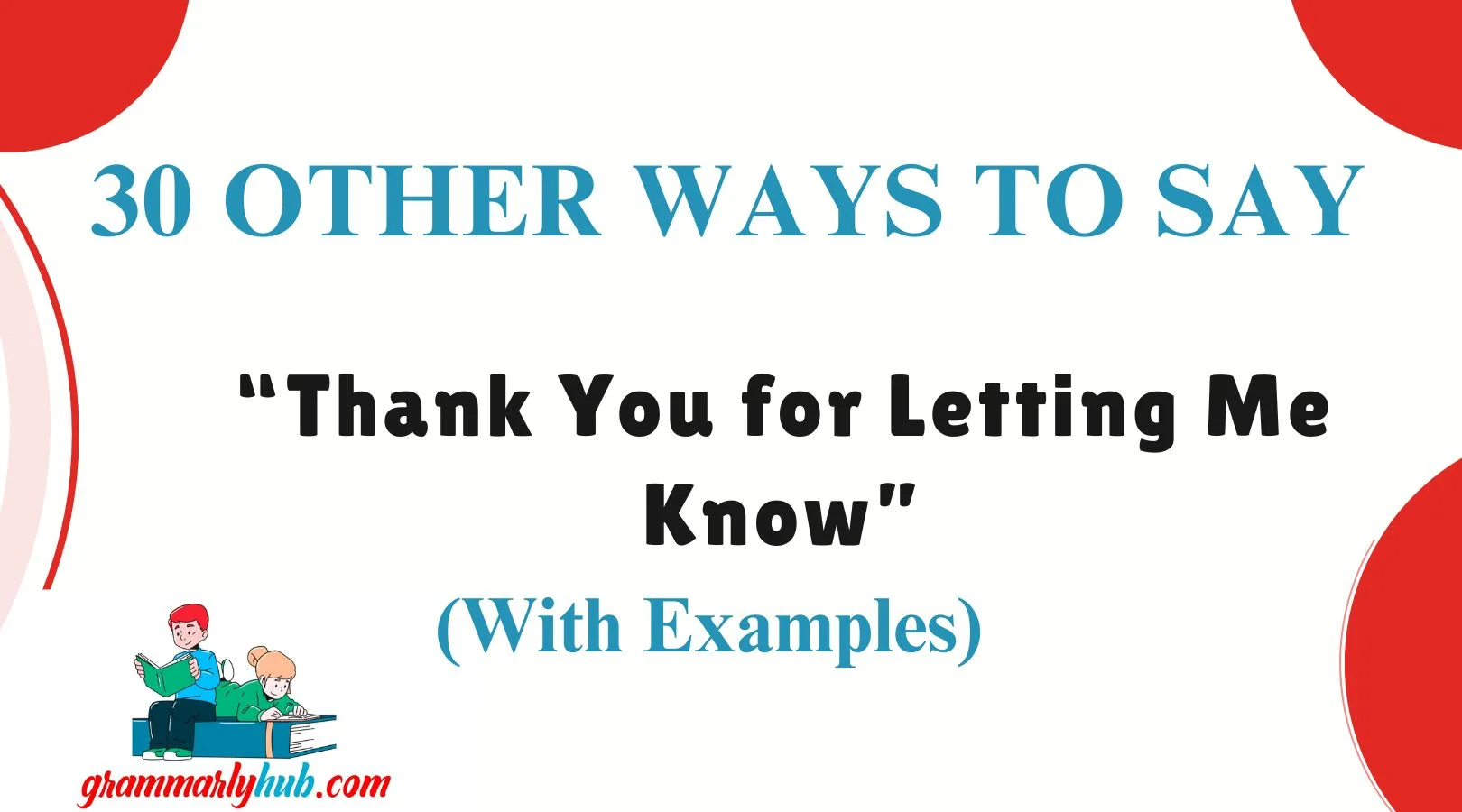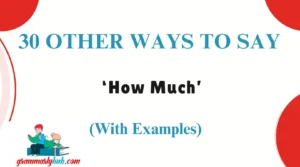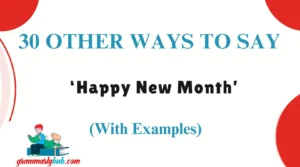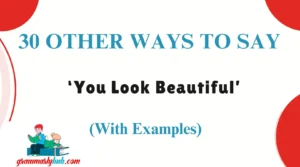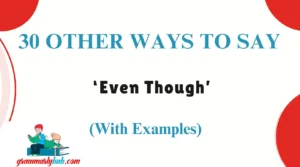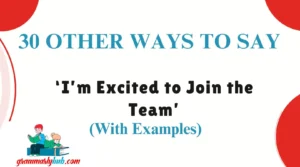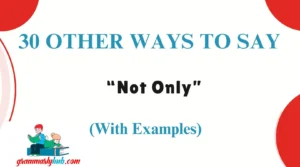When someone shares important information with you—whether in a personal or professional setting—responding with “Thank you for letting me know” is both polite and respectful. However, using the same phrase repeatedly can feel repetitive or impersonal. Finding other ways to say “thank you for letting me know” can help you communicate with more warmth, variety, and precision.
Whether you’re responding to an update, an alert, or a heads-up, having a range of alternative expressions for thank you for the update can make your responses feel more thoughtful and tailored.
In this guide, we’ll explore professional, casual, and empathetic alternatives that you can use in emails, messages, or conversations. Each suggestion includes examples so you can choose the best fit for your tone and context. Expand your communication toolkit and make your gratitude truly stand out.
What Does “Thank You for Letting Me Know” Mean?
“Thank you for letting me know” is a polite and appreciative phrase used to acknowledge that someone has shared information with you. It expresses gratitude for being informed about something, whether it’s an update, a change in plans, a concern, or important news. This phrase can be used in both formal and informal settings, and it helps maintain respectful and clear communication.
At its core, the phrase means:
- “I appreciate that you informed me.”
- “Thanks for keeping me in the loop.”
- “I’m grateful for the update or heads-up.”
It’s commonly used in emails, texts, and conversations to acknowledge someone’s effort in communicating. While it’s a go-to response, varying how you say it can make your message feel more personal, professional, or emotionally tuned to the situation.
When to Use “Thank You for Letting Me Know”
- When a colleague informs you of a change in schedule or task.
- When a friend shares important news or updates.
- When you receive clarification or information that affects your plans.
- In email replies to show attentiveness and appreciation.
Best Used In: Professional settings, customer service interactions, and personal conversations.
Is It Professional/Polite to Say “Thank You for Letting Me Know”?
Yes, it’s both professional and polite. It shows you’re respectful, receptive, and appreciative of someone’s communication. However, using variations based on tone, relationship, and context can help your message sound more authentic and engaging.
Pros and Cons of Saying “Thank You for Letting Me Know”
Pros:
- Clear and respectful
- Universally understood
- Appropriate in most formal and informal settings
Cons:
- Can sound repetitive or robotic if overused
- May feel too neutral in emotionally sensitive situations
- Doesn’t always convey deeper empathy or connection
Synonyms For “Thank You for Letting Me Know” (With Examples)
- I appreciate the update
- Thanks for the heads-up
- Thank you for the information
- I’m grateful you told me
- Thanks for keeping me posted
- Appreciate you letting me know
- I value the update
- Good to know—thank you
- Thanks for the insight
- I’m glad you told me
- Thanks for the notice
- Appreciate the heads-up
- That’s helpful—thank you
- Thank you for sharing that
- I’m thankful you mentioned it
- I’m grateful for the update
- Thanks for pointing that out
- I appreciate the clarification
- Thank you for informing me
- Thanks for taking the time to tell me
- I’m glad to be in the loop
- I appreciate your honesty
- Thanks for making me aware
- Appreciate the transparency
- Thank you for the heads-up
- Thanks for filling me in
- Thank you for the alert
- I appreciate your thoughtfulness
- Thank you for flagging this
- I’m thankful for the info
1. I Appreciate the Update
Definition: A warm way to express gratitude for new or recent information.
Explanation: This alternative is especially useful in professional settings when someone shares project progress or changes.
Example:
“I appreciate the update on the client’s feedback. It helps me adjust our approach.”
Worst Use: In personal conversations where emotional nuance is needed (e.g., serious news).
Tone: Professional, appreciative, and courteous.
2. Thanks for the Heads-Up
Definition: An informal, friendly way to thank someone for a timely warning or notice.
Explanation: This phrase works well when someone alerts you to something in advance, allowing you to prepare.
Example:
“Thanks for the heads-up about the schedule change—I’ll adjust accordingly.”
Worst Use: In highly formal or corporate communication.
Tone: Casual, conversational, proactive.
3. Thank You for the Information
Definition: A neutral and formal expression of gratitude for shared knowledge.
Explanation: Appropriate in professional emails or discussions where you’re acknowledging facts, data, or formal updates.
Example:
“Thank you for the information regarding the meeting agenda.”
Worst Use: In personal chats or with emotionally sensitive news—it can feel cold.
Tone: Professional, neutral, respectful.
4. I’m Grateful You Told Me
Definition: A heartfelt way to express thanks for someone’s openness or honesty.
Explanation: Ideal for personal or emotionally meaningful conversations where someone shares difficult or important news.
Example:
“I’m grateful you told me—it means a lot that you trusted me with this.”
Worst Use: Business emails or purely transactional updates.
Tone: Emotional, warm, sincere.
5. Thanks for Keeping Me Posted
Definition: A friendly way to thank someone for ongoing updates or continuous information.
Explanation: Great for casual or team interactions where updates are expected.
Example:
“Thanks for keeping me posted on the project status.”
Worst Use: When the update was a one-time or very formal message.
Tone: Casual, engaging, appreciative.
6. Appreciate You Letting Me Know
Definition: A conversational and heartfelt version of the original phrase.
Explanation: Works well in both personal and informal professional contexts.
Example:
“Appreciate you letting me know about the change in plans.”
Worst Use: Formal reports or client-facing communication.
Tone: Warm, relaxed, genuine.
7. I Value the Update
Definition: A respectful phrase showing that you not only heard the information but find it important.
Explanation: Best used in business contexts where you want to show appreciation and attention.
Example:
“I value the update and will review the changes closely.”
Worst Use: Light or humorous situations—it may sound too formal.
Tone: Respectful, professional.
8. Good to Know—Thank You
Definition: A concise and friendly phrase to express acknowledgment and appreciation.
Explanation: Best when the information is not critical but still useful.
Example:
“Oh, good to know—thank you for mentioning that!”
Worst Use: Serious conversations; may feel dismissive.
Tone: Casual, light, friendly.
9. Thanks for the Insight
Definition: A grateful response to someone offering helpful or thoughtful input.
Explanation: Great for feedback, brainstorming sessions, or suggestions.
Example:
“Thanks for the insight—your perspective is really helpful.”
Worst Use: Routine status updates or factual notices.
Tone: Reflective, appreciative.
10. I’m Glad You Told Me
Definition: Expresses appreciation and relief that someone shared something with you.
Explanation: Suitable for both personal and professional settings.
Example:
“I’m glad you told me—I wouldn’t have noticed the mistake otherwise.”
Worst Use: Highly formal reports or client briefings.
Tone: Warm, personable.
11. Thanks for the Notice
Definition: A simple acknowledgment when someone informs you of something in advance.
Explanation: This phrase is helpful when you’ve been given a timely alert, such as a change, delay, or warning.
Example:
“Thanks for the notice—I’ll make sure to reschedule my appointments.”
Worst Use: Emotional or deeply personal updates—it might sound transactional.
Tone: Polite, straightforward, professional.
12. Appreciate the Heads-Up
Definition: An informal way to thank someone for an early warning or useful update.
Explanation: Suitable in team environments, especially when someone alerts you before a deadline or issue.
Example:
“Appreciate the heads-up on the server downtime. I’ll notify the rest of the team.”
Worst Use: Legal or executive-level formal communication.
Tone: Friendly, informal, proactive.
13. That’s Helpful—Thank You
Definition: Expresses appreciation while recognizing the usefulness of the shared info.
Explanation: Perfect for instances where someone has clarified or provided actionable insights.
Example:
“That’s helpful—thank you for breaking that down for me.”
Worst Use: In brief or auto-reply style emails—it needs a human tone.
Tone: Warm, appreciative, conversational.
14. Thank You for Sharing That
Definition: A gentle and open expression of thanks when someone shares personal or sensitive information.
Explanation: Good in both professional and personal spaces, especially when empathy is key.
Example:
“Thank you for sharing that—it gives me a better understanding of your concerns.”
Worst Use: Informal chats about minor updates—it might feel too heavy.
Tone: Thoughtful, sincere, empathetic.
15. I’m Thankful You Mentioned It
Definition: Shows gratitude for something that might have otherwise gone unnoticed.
Explanation: Ideal when someone raises a point or offers feedback that proves insightful or protective.
Example:
“I’m thankful you mentioned it—I would have overlooked that step.”
Worst Use: Auto-responses or robotic customer service templates.
Tone: Reflective, warm, appreciative.
16. I’m Grateful for the Update
Definition: A heartfelt variation that expresses genuine appreciation for new information.
Explanation: This is suitable for both personal and formal settings where sincerity matters.
Example:
“I’m grateful for the update—please keep me informed moving forward.”
Worst Use: Overly casual exchanges—it might sound overly formal.
Tone: Formal, genuine, warm.
17. Thanks for Pointing That Out
Definition: Acknowledges when someone draws your attention to something specific.
Explanation: Especially helpful in collaborative environments like editing, design, or quality control.
Example:
“Thanks for pointing that out—I’ll revise the report accordingly.”
Worst Use: When someone shares emotional or personal updates.
Tone: Appreciative, responsive, constructive.
18. I Appreciate the Clarification
Definition: A polite thank-you when someone helps clear up confusion or misunderstanding.
Explanation: Ideal in meetings, emails, or feedback sessions where communication clarity matters.
Example:
“I appreciate the clarification about the timeline. That makes things much clearer.”
Worst Use: When no confusion existed; might seem unnecessary.
Tone: Professional, polite, precise.
19. Thank You for Informing Me
Definition: A formal and professional way of acknowledging received information.
Explanation: Common in corporate, legal, and administrative contexts.
Example:
“Thank you for informing me of the upcoming compliance deadline.”
Worst Use: Casual text messages or friend-to-friend updates.
Tone: Formal, respectful, reserved.
20. Thanks for Taking the Time to Tell Me
Definition: A kind way to acknowledge the effort someone took to communicate with you.
Explanation: This phrase works beautifully when you want to show gratitude for their time and thoughtfulness.
Example:
“Thanks for taking the time to tell me about your concerns—I really appreciate it.”
Worst Use: Automated replies or rushed conversations.
Tone: Gracious, warm, empathetic.
21. I’m Glad to Be in the Loop
Definition: A light, friendly way to express thanks for being included or updated.
Explanation: Often used in group projects or team updates to signal involvement.
Example:
“I’m glad to be in the loop—let me know how I can help next.”
Worst Use: Serious or emotional updates—it may sound too casual.
Tone: Friendly, inclusive, informal.
22. I Appreciate Your Honesty
Definition: A response that shows gratitude when someone is transparent or shares something candidly.
Explanation: Great in both personal and professional settings where trust matters.
Example:
“I appreciate your honesty about the challenges—we’ll work through them together.”
Worst Use: Basic updates or neutral information—it may seem misplaced.
Tone: Respectful, sincere, emotionally intelligent
23. Thanks for Making Me Aware
Definition: A calm and composed way to thank someone for bringing something to your attention.
Explanation: Works well in leadership and managerial communications.
Example:
“Thanks for making me aware of the issue—we’ll address it promptly.”
Worst Use: Extremely casual chats—it might feel stiff.
Tone: Balanced, professional, composed.
24. Appreciate the Transparency
Definition: Shows you value openness and clarity, especially in decision-making or feedback.
Explanation: Best used when someone shares something that helps build trust or clear up misunderstandings.
Example:
“Appreciate the transparency—it helps us build a better working relationship.”
Worst Use: Light or joking conversations—it sounds too serious.
Tone: Trust-building, professional, thoughtful.
25. Thank You for the Heads-Up
Definition: Very similar to “Thanks for the heads-up,” but slightly more formal.
Explanation: Ideal in professional settings where you want to acknowledge a useful early notice.
Example:
“Thank you for the heads-up about the upcoming inspection.”
Worst Use: In deeply emotional or personal conversations.
Tone: Professional, timely, polite.
26. Thanks for Filling Me In
Definition: A relaxed way to thank someone for catching you up on something.
Explanation: Great for casual office environments or when rejoining a discussion.
Example:
“Thanks for filling me in on what I missed during the call.”
Worst Use: Formal documents or executive communication.
Tone: Conversational, approachable, relaxed.
27. Thank You for the Alert
Definition: A straightforward phrase that acknowledges a warning or risk shared with you.
Explanation: Appropriate in contexts involving safety, security, or compliance.
Example:
“Thank you for the alert—we’ll escalate the matter to IT.”
Worst Use: Personal updates or emotional news—it may feel robotic.
Tone: Responsible, serious, direct.
28. I Appreciate Your Thoughtfulness
Definition: A warm expression when someone shares something that shows they care about you or your situation.
Explanation: Best used in emotionally intelligent interactions, like when someone shares personal advice or concern.
Example:
“I appreciate your thoughtfulness in telling me—your support means a lot.”
Worst Use: Strictly factual updates with no emotional layer.
Tone: Kind, empathetic, sincere.
29. Thank You for Flagging This
Definition: A modern, proactive phrase used when someone spots and raises an issue.
Explanation: Excellent in professional spaces, especially when it comes to risks, errors, or red flags.
Example:
“Thank you for flagging this error—we’ll correct it before launch.”
Worst Use: Outside of technical or business contexts—it may confuse others.
Tone: Alert, solution-focused, appreciative.
30. I’m Thankful for the Info
Definition: A more heartfelt variation of “Thanks for the info,” expressing deeper appreciation.
Explanation: Works well when someone takes time to share something meaningful or helpful to your decision-making.
Example:
“I’m thankful for the info—it helps me make a more informed choice.”
Worst Use: In ultra-formal contexts—may sound slightly casual.
Tone: Grateful, genuine, semi-formal.
Conclusion: Expressing Gratitude with Heart and Intention
“Thank you for letting me know” is a respectful and useful phrase, but language is a powerful tool—and using a variation can show deeper care, professionalism, or emotional understanding. By choosing the right tone and words, you not only express gratitude but also strengthen relationships, build trust, and make communication feel more human. Whether you’re speaking to a friend, coworker, or client, these 30 alternatives help you connect more thoughtfully.
FAQs
1. Is it polite to say “Thank you for letting me know”?
Yes, absolutely. It’s one of the most common and polite ways to acknowledge someone’s effort in sharing information. It shows appreciation, respect, and attentiveness, especially in both professional and casual conversations.
2. Can I use “Thank you for letting me know” in a formal email?
Yes. While it’s slightly more conversational than some formal expressions, it is still acceptable in most business contexts. If you need a more formal variation, try “Thank you for informing me” or “I appreciate the update.”
3. What is a more emotional or heartfelt alternative?
If you want to express more empathy or warmth, try phrases like:
- “I’m grateful you told me.”
- “Thank you for sharing that.”
- “I appreciate your honesty.”
These phrases are especially useful in sensitive or personal conversations
4. What can I say instead of “Thanks for letting me know” in customer service?
In customer support, tone matters. Choose phrases like:
- “Thank you for bringing this to our attention.”
- “I appreciate the heads-up.”
- “Thank you for your feedback.”
These phrases sound professional, polite, and customer-focused.
5. What’s the difference between “Thanks for the heads-up” and “Thank you for letting me know”?
“Thanks for the heads-up” is more informal and proactive, typically used when someone warns you about something before it happens.“Thank you for letting me know” is broader and can apply to any update—before or after something occurs.

Emma Brooke is the voice behind Grammarly Hub, where grammar meets clarity. With a deep passion for the written word, Emma helps readers navigate the tricky waters of English grammar, writing tips, and effective communication.
